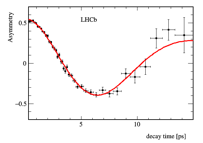[ γ=(70.9+7.1-8.5)° ; Δmd=(505.0±2.1±1.0)ns-1 ; X(5568) not confirmed ]
The LHCb Collaboration has presented today at the Rencontres de Moriond EW new important results.

(1) CKM γ angle measurements. The parameters that describe the difference in behaviour between matter and antimatter, known as CP violation, are constrained in the so called CKM, or unitarity, triangle. The angles of this triangle are denoted α, β and γ, and among these, γ is the least precisely known. A detailed introduction to the measurement of γ can be found in the 5 October 2012 news and in this CERN Courier article. The γ value of (70.9+7.1-8.5)° presented today was obtained from the combination of many different LHCb measurements, notably including some new results unveiled today for the first time, and is the most precise determination of γ from a single experiment. One of the new analyses presented today uses decays of charged B mesons into charmed D mesons and pions π or kaons K. Then the D mesons decay in turn into various combinations of π’s and K’s. The image displays the different rates of positive and negative B mesons, clearly indicating different properties of matter and antimatter.
(2) Determination of the B0 oscillation frequency. A fascinating feature of quantum mechanics, in which the B0s, B0 and D0 particles turn into their antimatter partners, has been discussed already few times at this page, see 15 March 2011, 7 November 2012 and 3 March 2013 news. This feature is called oscillation or mixing. LHCb physicists presented today the most precise single measurement of the parameter which sets the B0 meson oscillation frequency to be Δmd=(505.0±2.1±1.0) ns-1. The full run1 data sample of semileptonic B0 decays with charged D or D* mesons was used in this analysis. The image shows the characteristic oscillation pattern of B0 mesons.
(3) Non-confirmation of the X(5568) tetraquark candidate. Two weeks ago the D0 Collaboration at Fermilab reported the observation of a narrow structure, X(5568), in the invariant mass of the Bs0 meson and a charged pion π, see Fig. 3 in the D0 publication, and interpreted it as a tetraquark candidate composed of four different quarks (b, s, u and d). An introduction to four-quark systems, or tetraquarks, can be found in the 9 April 2014 news.
The LHCb Collaboration reported today a result of a similar analysis using a sample of Bs0 mesons 20 times higher than that used by the D0 Collaboration. The Bs0π invariant mass spectrum is shown in the figure using the Bs0 mesons decaying into J/ψ and φ mesons or into Ds and π mesons. No structure is seen in the region around the mass of 5568 MeV (indicated by the arrow). Hence the LHCb analysis does not confirm the D0 result. Read more in the LHCb conference note, in the LHCb paper, in the LHCb CERN seminar and also in the LHCb presentation at the Rencontres de Moriond QCD.


